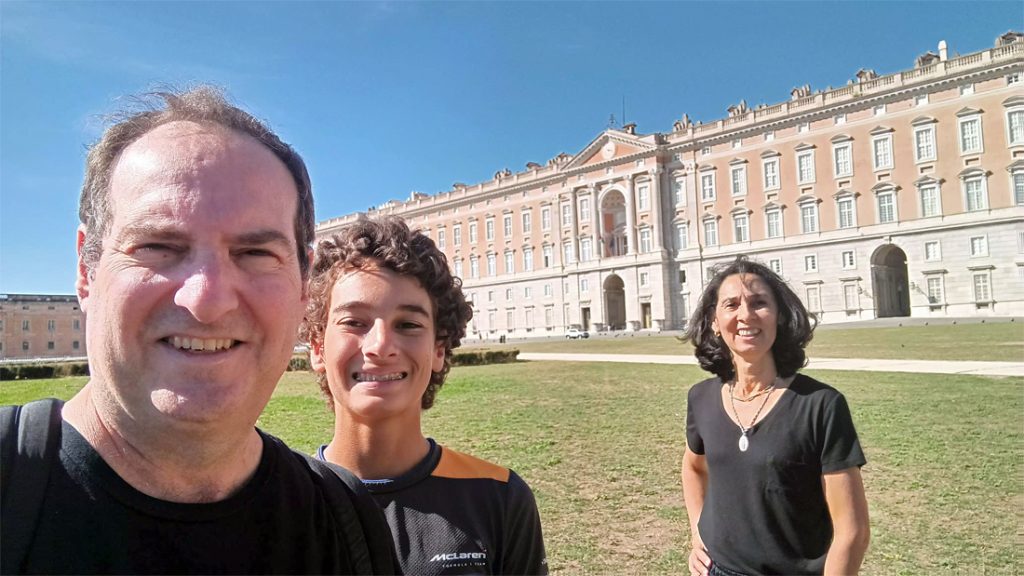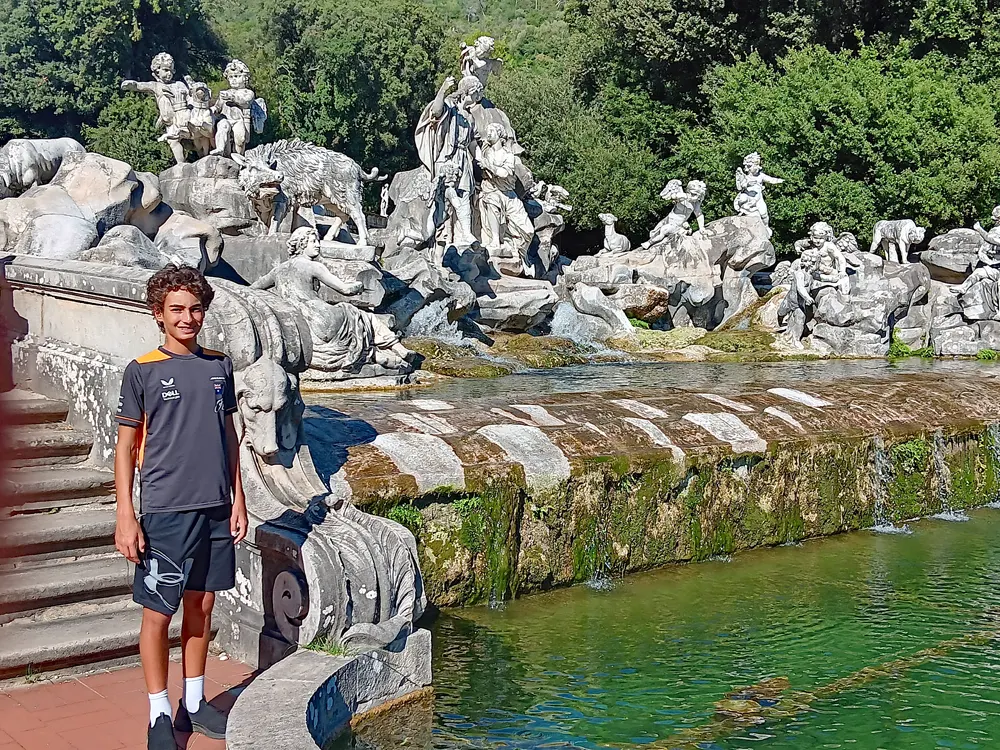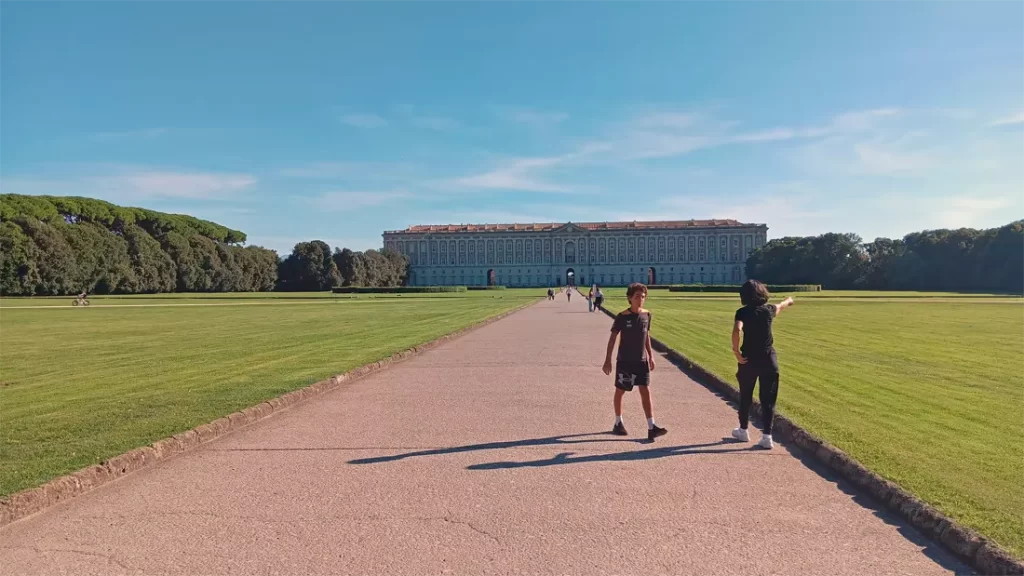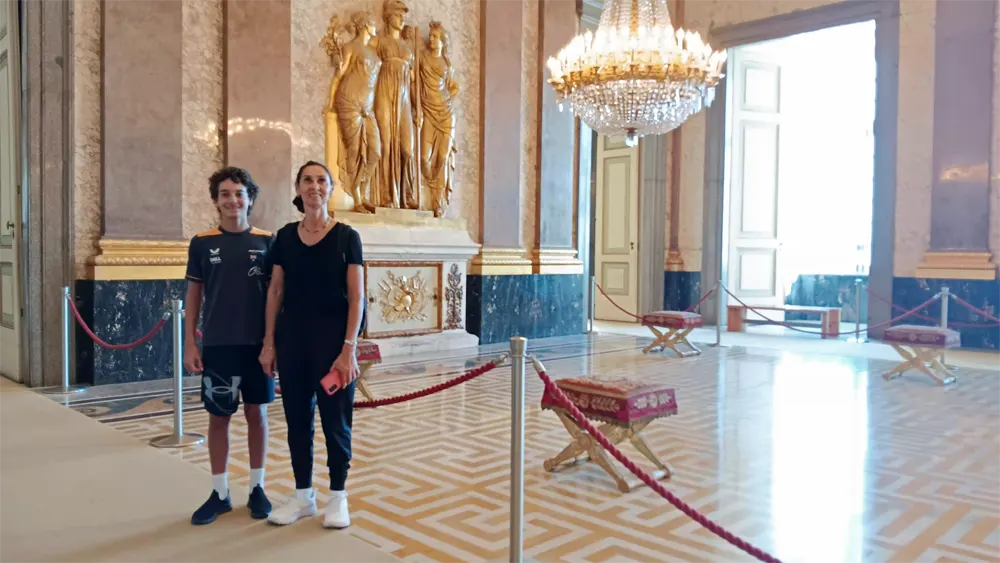
Royal Palace of Caserta (Reggia di Caserta)
We’ve always wanted to visit the Royal Palace of Caserta. The big royal palace and gardens look like the Palace of Versailles in France, with its miles long lawn, water features, and gardens. Its majestic atmosphere is mesmerizing in photos. It was one of the largest royal residences in the world. Today it belongs to the Italian state and is a UNESCO world heritage site.
The palace is in Campania, southern Italy, near Naples and Pompeii. We made a day trip from Rome as it was a stop on our way to Matera and Puglia. Typically we would have flown from Rome to Bari or Brindisi in Puglia. But since we wanted to visit the Palace we made a road trip out of planning to visit Caserta.
The visit was well worth the effort. Frankly, I thought the palace was in better condition than Versailles. And with considerably less people it was a pleasurable place to visit.
How to Plan Day Trip from Naples and Rome
You may easily get to Caserta by air, as it is close to Naples airport. The Caserta train station is literally across the street from the main entrance making it easily accessible by train from Naples and Rome.
Or, as we did, you can plan the visit by car. Parking around the palace is a little tricky. When we visited in September 2025 there was construction around the palace main entrance. The parking lot i.e. parcheggio that Waze directed us to in front of the palace was not open. We found on street parking.
Upon finding parking we ducted into a local caffe for a quick espresso. Then we were ready for an afternoon of sightseeing.
We planned to make a half day visit. After visiting I would say at least half a day is necessary to enjoy the gardens and palace tour.
Since we knew we would be driving from Rome and continuing to Matera, we booked a hotel room in Caserta for the evening. Of course, it is tempting to stay in Naples but that would have set us back from our primary goal for this trip, which was to enjoy Puglia.
For dinner in Caserta we made reservations to visit “one of the best pizzerias in the world”, Pepi In Grani. This is about 30 to 40 minutes outside of Caserta. There are also plenty of “best in the world” pizzerias right in Caserta. But we opted for as our teenager would say the “full send it” pizzeria experience.
Tour of Royal Palace
The palace is open to the public daily except Tuesday. We bought tickets for both the palace and the garden. There was no queue. Frankly, it was like we had the place to ourselves. So no need to worry about skip the line tickets.
Cost for combined garden and palace ticket is about 18 Euro. The garden only ticket is 12 euro. The palace only ticket is 5 euro.
The regular hours vary by season. Generally the hours are:
Open every day except Tuesday.
Closed on Jan 1, May 1, and Dec 25.
Hours: Palace & Interiors (Royal Apartments, Throne Room, Palatine Chapel, etc.)
April – September (high season): ~ 8:30 am to 7:30 pm (last entry ~ 6:15-6:30 pm) November – March (low season): shorter hours (closing about 5:30 pm), with last entry earlier.
Hours: Gardens, Park & English Garden
English Garden and Royal Park hours vary with the season. Typically they open at the same time as the palace (~8:30 am) but close earlier than the interior.
For example, during summer (April-September) the park may close ~7:00 pm, while in winter months it could be ~3:30-4:00 pm.
The Gardens

We decided to stroll around the garden and palace grounds first. The garden is about 2 miles long. To explore the gardens there are options for golf cart rides with a driver, bus rides, and even bike rentals.
Bike rentals looks to be lots of fun. We opted for the bus to take us to the far side of the garden where the fountain and English garden are located. And then we walked back to the palace. It was a delightful stroll on a perfect September day.
The garden is beautiful. The water feature with cascading falls down toward the palace add to the magical ambiance.
The Palace

After the gardens we headed inside the palace, entering through the grand staircase. It’s stunning—and instantly recognizable. The architect was Carlo Vanvitelli.
Parts of these stairways and halls were turned into Queen Amidala’s palace on Naboo for Star Wars: The Phantom Menace and Attack of the Clones.
Walking through them really felt like stepping into the movies. One thing we like to do when traveling is let our son choose spots that interest him, and this visit was actually his idea. Our 14-year-old insisted we check out the Royal Palace, and we’re so glad he did.
Royal Apartments

The royal apartment is in very good condition. There is furniture and artwork arer from the period. The deocration illuminated life in Naples in the 18th century.
Looking out the windows from the Throne Room we could see way out in the distance the Isle of Capri. Close and more imposing was the view of Mt Vesuvius.
While visiting we discussed the history, which allows for some teaching in an interesting way.
The Royal Palace of Caserta (Reggia di Caserta) has a fascinating history and a clear connection to Versailles. The palace was commissioned by King Charles VII of Naples (later Charles III of Spain) in 1752. Its purpose was to serve as a grand royal residence for the Bourbon kings of Naples and to rival other European palaces. Like Versailles, Caserta has vast gardens with fountains, cascades, and tree-lined avenues, but it’s even larger in floor area than Versailles.
Both palaces were designed to show royal prestige and grandeur. While Versailles influenced its design, Caserta also reflects Italian Baroque style, and its interiors are uniquely Italian in decoration.
The Royal Palace of Caserta is also connected to the Royal Palace of Capodimonte in Naples. Both were built by Charles VII.
Caserta was meant to be the grand showpiece—like a southern Versailles—while Capodimonte started out as a place to display the huge Farnese art collection he inherited from his mother, and later doubled as a hunting lodge and residence. So in a way, the two palaces tell different sides of the same royal story.
Royal Chapel – Cappella Palatina
One of the most impressive rooms is the Royal Chapel of the Caserta Palace (Cappella Palatina). It is one of the palace’s most impressive interior spaces, combining religious grandeur with Bourbon royal symbolism.
1. Purpose: Built as the private chapel for the Bourbon royal family of Naples. Served for daily mass, royal ceremonies, and important events within the palace.
Symbolized the close relationship between the monarchy and the Catholic Church, a key source of legitimacy for the Bourbons.
2. Architecture Style: Late Baroque, leaning into early Neoclassical influence. Designed by Luigi Vanvitelli, the same architect who designed the palace itself.
Layout: Rectangular nave with a richly decorated altar; elegantly proportioned to fit harmoniously inside the grand palace setting.
3. Decoration:
Frescoes: The ceiling and walls are covered with intricate frescoes depicting biblical scenes, saints, and allegories of royal power.
Marble Work: Polished marble columns and floors reflect Italian craftsmanship, with geometric and floral patterns.
Altarpiece: Richly gilded, featuring scenes of Christ and the Virgin Mary, symbolizing divine sanction for Bourbon rule.
4. Symbolism: The chapel was designed to link religion and monarchy: worshiping here reaffirmed the idea that the Bourbons ruled with divine approval.
Its opulence also reinforced Bourbon prestige, much like Versailles’ Chapel reinforced French royal power.
5. Location: Situated centrally within the palace, at the top of the stairs seen in the Star Wars movies near the royal apartments, so the king and court could easily access it.
Positioned to complement the grand staircase and the main ceremonial areas, making it part of the palace’s “power circuit.”
The chapel is sometimes compared to the chapel at Versailles, but Caserta’s design reflects more restrained elegance typical of Vanvitelli’s style, blending Baroque drama with Neapolitan refinement.
Private Tours and Guided Tours to Visit the Royal Caserta Palace
Below are various options for guided tours, private tours, and audio guides. There are tours from Rome and Naples. Also, check out our all inclusive southern Italy tours.
History of the Royal Palace of Caserta
1. Separate Kingdoms, Separate Crowns
- Even though the Bourbons ruled both France and Naples (via Philip V’s grandfather Louis XIV and Charles VII), France and Naples were independent kingdoms.
- Philip V’s grandfather (Louis XIV) ruled France, and Charles VII ruled Naples. Being related didn’t automatically confer authority in Naples. Local nobility, the population, and other European powers needed visible signs of sovereignty.
2. Legitimacy and Prestige in Naples
- The Bourbons were new rulers in Naples, taking over after the Spanish Habsburgs (via the Treaty of Vienna, 1734).
- The Neapolitan nobility and people had long memories of Habsburg rule; the Bourbons were outsiders.
- Caserta was meant to signal: “We are just as legitimate and powerful as any other great European monarchy” — a local Versailles to impress both locals and foreign ambassadors.
3. Symbolism vs. Family Connections
- Family ties mattered, but power projection mattered more.
- A palace like Caserta wasn’t just decoration: it was administration, court life, culture, and defense in one. It was a physical demonstration that the Bourbon presence in Naples was permanent and sovereign, not just a French extension.
4. European Rivalries
- Other European powers (Austria, Britain, Spain) were watching Naples closely.
- Showing grandeur like Versailles was a way to command respect internationally — signaling that the Bourbon king of Naples could stand on his own, separate from France.
In short, even though the Bourbons already ruled France, in Naples they were new rulers who needed local legitimacy, authority, and international recognition. Caserta wasn’t about family pride alone — it was political theater, power projection, and administrative strategy.
The Royal Palace of Caserta was a Bourbon project, designed to rival Habsburg and French palaces.
- Habsburgs ruled Naples 1714–1734 (Charles VI).
- Bourbons ruled Naples 1734–1861 (Charles VII → Ferdinand IV → successors).
Naples Royal Timeline – Habsburgs → Bourbons
1700–1713: War of Spanish Succession
- Conflict over Spanish territories. Naples changes hands between Spanish and Austrian claims.
1714–1734: Habsburg Rule
- Charles VI, Holy Roman Emperor (Austrian Habsburg) becomes King of Naples after the Treaty of Utrecht.
- Naples under Austrian administration; Habsburgs implement reforms and maintain imperial control.
1734: Bourbon Takeover
- Charles of Bourbon (later Charles VII of Naples, then Charles III of Spain) conquers Naples during the War of the Polish Succession.
- Begins the Bourbon dynasty in Naples, ending Habsburg rule.
1734–1759: Charles VII of Naples
- Commissions Royal Palace of Caserta as a grand residence.
- Moves to Spain in 1759 to become King Charles III of Spain.
1759–1825: Ferdinand IV of Naples (Bourbon)
- Charles VII’s son continues Bourbon rule.
- Palace completed; Naples flourishes under Bourbon monarchy.
1861: Kingdom of Italy
- Bourbon rule ends; Naples becomes part of unified Italy.
Here’s a simple chart of the Habsburg and Bourbon kings of Naples, with their reigns:
| Dynasty | King | Reign in Naples | Notes |
| Habsburg | Charles VI, Holy Roman Emperor | 1714 – 1734 | Austrian Habsburg; ruled after Treaty of Utrecht; reforms Naples administration. |
| Bourbon | Charles VII of Naples (later Charles III of Spain) | 1734 – 1759 | Conquered Naples from Habsburgs; commissioned Royal Palace of Caserta. |
| Bourbon | Ferdinand IV of Naples | 1759 – 1825 | Son of Charles VII; continued palace construction; ruled through Napoleonic period. |
| Bourbon | Ferdinand I of the Two Sicilies | 1816 – 1825 | Naples merged with Sicily to form the Kingdom of the Two Sicilies. |
| Bourbon | Francis I of the Two Sicilies | 1825 – 1830 | Continued Bourbon rule. |
| Bourbon | Ferdinand II of the Two Sicilies | 1830 – 1859 | Last major Bourbon ruler before Italian unification. |
| Bourbon | Francis II of the Two Sicilies | 1859 – 1861 | Deposed after Kingdom of Italy formed. |
Summary
- Habsburg rule ended in 1734 with the Bourbon conquest.
- Caserta Palace was fully a Bourbon creation, not Habsburg.
- Bourbon kings ruled Naples and later the Two Sicilies until 1861.
- 1861 the palace becomes property of the Italian state.



